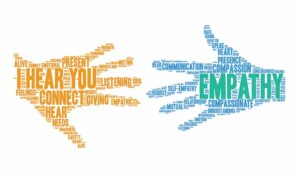What’s the one skill that every customer support agent should have?
Ask this question to anyone who has served in customer support, and they will have customer empathy high on their list.
Customer empathy – an idea that might have seemed like a lip-service or buzzword in the past, is now proving to be a competitive differentiator.
Customer empathy, just like customer experience, could mean different things to different industries, disciplines, and people.
But is there a common thread that we can all agree upon?
Is there an industry standard when it comes to understanding customer empathy?
What Is Customer Empathy?
Empathy could be defined as the ability to understand the point of view as well as feelings of others and be able to put yourself in their shoes to see a problem from their perspective.
When it comes to customer service, empathy is the ability to maintain a human interaction with the customer.
Looking at some of the most spectacular customer service failures that have been widely talked about in the media, you’ll realize that they involve a great lack of empathy.
Being empathetic, however, doesn’t mean that you agree with someone. It only implies that you understand their truth or their perspective.
It is a crucial character trait for customer support agents to possess, because they must talk to different customers on a daily basis and solve their problems – sometimes dealing with difficult, angry, and irate customers – while still representing the company in a good way.
Higher empathy results in increased customer loyalty, customer satisfaction, stronger financial performance, and greater innovation.
According to HBR’s 2016 Empathy Index report, the top 10 most empathetic companies boost their financial value two times as much as companies that land in the bottom 10.
This shouldn’t be a surprise since empathy is an essential skill for being able to anticipate, respond to, and eventually meet customer needs.
Tips for Deepening Customer Empathy
Is your team looking to deepen empathy with your customers? Here are some tips to help.
1. Observe, Interview, Engage
The easiest way to deepen customer empathy is take a researcher’s approach and go where customers directly interact with your services or products.
Watch your customers. How are they behaving? Think about where they always go before and after interactions with your company. After getting a quick sense of who they really are, inquire about their typical day.
Ask about their pain points in relation to what you’re offering them. Ask more about their opinions, thoughts, and feelings on everything surrounding your offerings.
Now, practice excellent customer listening and act as a customer. Imagine yourself in their physical, mental, and emotional experiences so that you can refine your services or products to meet their needs.
This way, you will better know how they feel and are better able to fine-tune your product or service to meet their unique needs and wants.
The rule of thumb here is putting yourself in the customers’ shoes so that you can better anticipate and meet their needs.
2. Share Customer Insights
Customers often share their experiences with companies on the Internet.
It is likely that you will need to rely on technology tools to look through thousands of product reviews, emails, and social media posts, but doing so will help you acquire more insight into what customers feel and think about your company.
Gather and share this information with everyone in the company and design ways to use the insights to create a better customer experience.
3. Create an Empathy Map
An empathy map helps you better understand the customer and get some clarity into what’s going on in their minds and hearts.
This map targets your customer’s emotions and takes into account customer experiences within four categories:
- What they feel and think;
- say and do;
- hear; and
- see
To complete an empathy map, you will need to analyze your relationship with the customers. Do you know how they actually feel and what they’re thinking?
Are you aware of what you’re solving for? It is essential that you gather the necessary information if you don’t already know the answers.
An empathy map could work well as a follow-up activity after you have observed, interviewed, and engaged with your customer. Ensure you answer from a customer’s perspective rather than how you’d like them to feel.
4. Include Understanding Phrases in Your Customer Service Interactions
When a customer calls customer service, it’s your chance to turn a potentially negative experience into something positive. Phrases like, “I know how frustrating it can be when this happens,” or, “I am so sorry you’re facing this problem,” display great empathy and let your customers know that you understand what they’re going through.
These phrases work best when paired with assurances that you’ll do everything possible to resolve the issue promptly.
However, you should be careful not to overdo it; empathy works best when it is genuine and doesn’t seem exaggerated.
5. Examine Your Biases
We often have hidden and, at times, not-so-hidden biases that could interfere with our ability to empathize and listen. Most of these biases are often centered around visible factors like gender, age, and race.
If you have a bias, even an unconscious one, towards a certain category of customers, it’s typically obvious to customers during your interactions with them.
You should always try to be as neutral as possible while dealing with different customers, treating every customer the same way – the way that you’d expect to (or would want to) be treated.
It obviously pays to gain awareness about customer empathy, but it’s even more important to act and take steps to build and deepen customer empathy throughout your organization.
Paying attention to your customers’ needs and taking the necessary steps to address them can be incredibly rewarding. There’s always room for improvement, and it’s never too late to be better.
This blog post has been re-published by kind permission of CallMiner – View the Original Article
For more information about CallMiner - visit the CallMiner Website
Call Centre Helper is not responsible for the content of these guest blog posts. The opinions expressed in this article are those of the author, and do not necessarily reflect those of Call Centre Helper.
Author: CallMiner
Published On: 18th Oct 2019 - Last modified: 18th Feb 2020
Read more about - Guest Blogs, CallMiner






 CallMiner is the leading cloud-based customer interaction analytics solution for extracting business intelligence and improving agent performance across all contact channels.
CallMiner is the leading cloud-based customer interaction analytics solution for extracting business intelligence and improving agent performance across all contact channels. 












